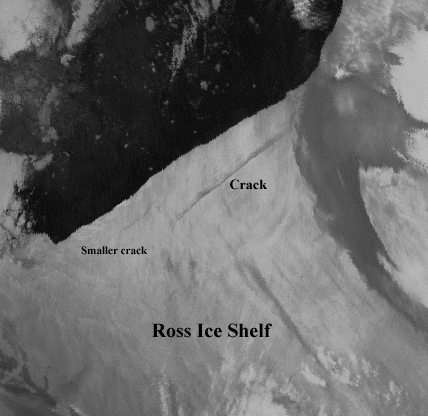
The ATSR Project
|

ATSR clearly identifies significant rift in the Ross Ice Shelf
A visible night-time 12 micron image, taken on the 21st December 2000.
|
The image clearly shows cracks, appearing in the eastern end of the Ross Ice Shelf in the Antarctic. These cracks are better known as 'rifts' according to Neal Young of the Antarctic Cooperative Research Centre, Australia. He also added that these, 'rifts develop as a natural consequence of the motion (in particular the straining or deformation of the ice. They are already present many tens and even hundreds of kilometers in front of an ice shelf, typically developing over time' . It appears that these rifts have recently grown larger and are likely to form the next calving from the Ross Ice Shelf. |
According to those from the University of Wisconsin-Madison these cracks or rifts,'have not changed significally from prior developments in 1997, with these particular cracks forming in 1988'. Their current thinking is that these cracks or rifts become more noticeable with the summer season and the lesser degree of snow bridging and so on. As a result, a future calving from the Ross Ice shelf could be many months or even years away, with it consequently being very hard to predict the time if its occurence.
The ATSR-2 instrument has been used to track the B-15 iceberg for well over a year now and this is another development from the study of such an ineteresing natural phenomena. The progress of B-15 will continue to be closely monitored by those within the Space Science and Technology Department at RAL and others.
Page last modified : Thursday, 06-Dec-07
